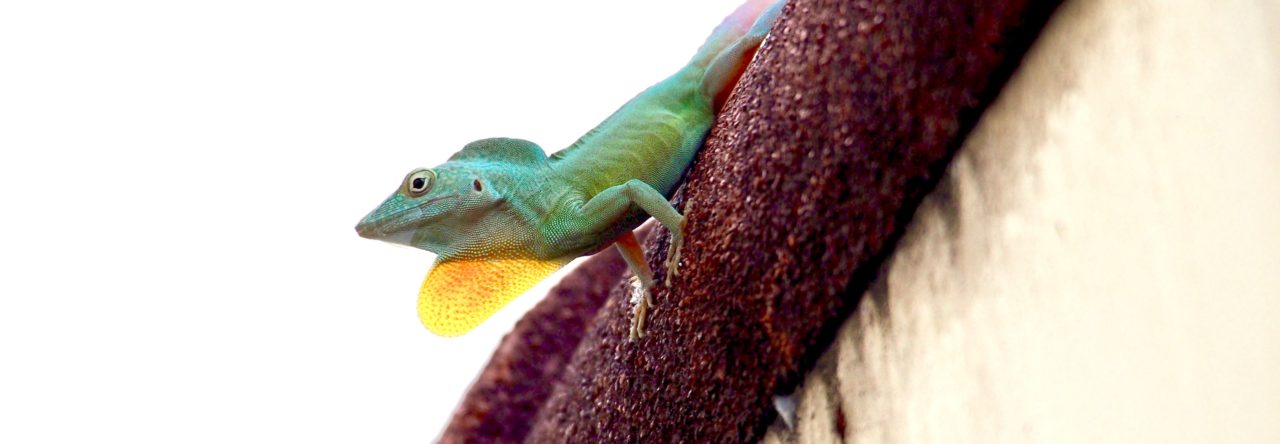Veronika Holáňová of Charles University in Prague not only studies anoles, but she breeds them in great quantities, including these wonderful Chamaeleolis. The “false chameleons” as they are called are renowned for specializing on eating snails as adults, and here are some of Veronika’s photos of them in the act.



Compare the broad, crushing teeth of Chamaelolis, below, to the pointier teeth of A. equestris above. Photo by Luke Mahler from Lizards in an Evolutionary Tree
This molluscivory is aided by large, flat, molar-like teeth at the back of their jaws.
For more on Chamaeleolis husbandry, check out this previous post.
- Evolution in Real Time on Lizard Island - March 23, 2025
- Spider Snags Adult Anolis osa - March 22, 2025
- An Homage to the Green Anoles of New Orleans - March 21, 2025



Harry Greene
Stunning images, and looks as if, like the teiid Dracaena, these lizards are cracking the shells rather deliberately, flicking fragments out with their tongues, and so forth. Wouldn’t it be cool to study the ontogeny of snail handling, relative to shell size of course, in these wonderful animals?
Rich Glor
Dracaena is definitely one of the coolest non-anole lizards on the planet. If memory serves the St. Louis Zoo used to feed their captive animals on giant African snails. I once saw one swimming in the Amazon and regret to this day that I didn’t dive in to grab it, but it was one of my first days on the river, and fear of the unknown (sunken snags, caiman, pirhana) prevented me from taking the plunge.
Simon Le Boulh
In the same vein, another cool thing to study would be why the juveniles, even if they don’t have molariform teeth, can crunch snails in the same way, and when/how does the change occur… Great pictures by the way !
Jérôme Guerlotté
This Anolis marmoratus girafus in attach file is somewhat presumptuous to want to eat this snail stone !
Rich Glor
@Jérôme Do you need some help with the attachement?
Will Baugher
Our Chamaeleolis eat the shells of the snails as well. Some bits fall out as they eat, but they consume most of it. They do just fine without snails when we feed them pinky mice weekly, but they do LOVE to eat snails as often as I can collect them. The juveniles take tiny snails as well, but seem to do so less eagerly than the adults. We will often feed the youngsters isopods instead, which they seem to enjoy as well. After feeding 50 adults their snails, the room turns into a chorus of snail crunching immediately.
We used to feed our Dracaena apple snails, but they reproduce and grow just fine feeding them bits of pinky rats, fish, and some fruit and baby food occassionally. I would love to see one in the wild!
Veronika Holanova
Thanks to Jonathan for posting this! Chamaeleolis species are my number one reptiles 🙂 There are so many interesting things for study in Chamaeleolis and I hope that some of them I will work on. I will inform you! If someboby is interested: together with Anthony Herrel we looked closely at bite force in Chamaeleolis lizards (Herrel A. & Holáňová V. 2008. Cranial morphology and bite force in Chamaeleolis lizards: Adaptations to molluscivory? Zoology 111: 467-475. ). and with other team we looked at Dracaena’s feeding strategy (Schaerlaeken V. et al. 2012. Built to bite: feeding kinematics, bite forces, and head shape of a specialized durophagous lizard, Dracaena guianensis (Teiidae). J. Exp. Zool. 00:1–11.). These molluscivory reptiles are so great!
Anyway, I also breed giant anoles (Anolis smallwoodi, Anolis noblei, Anolis equestris,..) and some species also love to feed on snails! But as they lack mollariform teeth, they swallow whole snail!!
Will Baugher
I would love to talk to you about your smallwoodi if possible. If you would be available please send me a message at wbaugher@nashvillezoo.org so that I can ask you a few questions. Thanks in advance for any help I could get. For whatever reason I am having trouble breeding this species while my others seem to be breeding just fine.
Thanks,
Will
Veronika Holanova
And one Dracaena crusher 🙂
Rich Glor
Awesome shot! It looks like that guy is good at clearing his plate. Thanks for sharing.
Franco Saller
Dear Dr. Holanova
can you tell me who are these species that lack molariform teeth and swallow whole snails?
Do you have some pictures of the teeth and skull of Chamaeleolis, maybe a view of the palatal vault?
Thank you
Franco
Karch Peter
Zahn Konstruktionen bei Tierarten …stehen immer sinngemäß zur Ernährung von
dieser . Bei Chamaeleolis ( Anolis ) mit seine bis heute 6 . Arten ….ist dies richtig ,wenn
auch nur bedingt zum Thema Snail crushing ….Ch. porcus hat vom Prinzip eine Zahn –
Konstruktion welche dem von Anolis equestris zu zuordnen wäre …im Wissen , dass auch A. equestris dazu neigt Schnecken zu fressen (crushen ) jedoch mehr Insektivoren
…und Kleinechsen im Nahrungsspektrum nahe legen lässt .